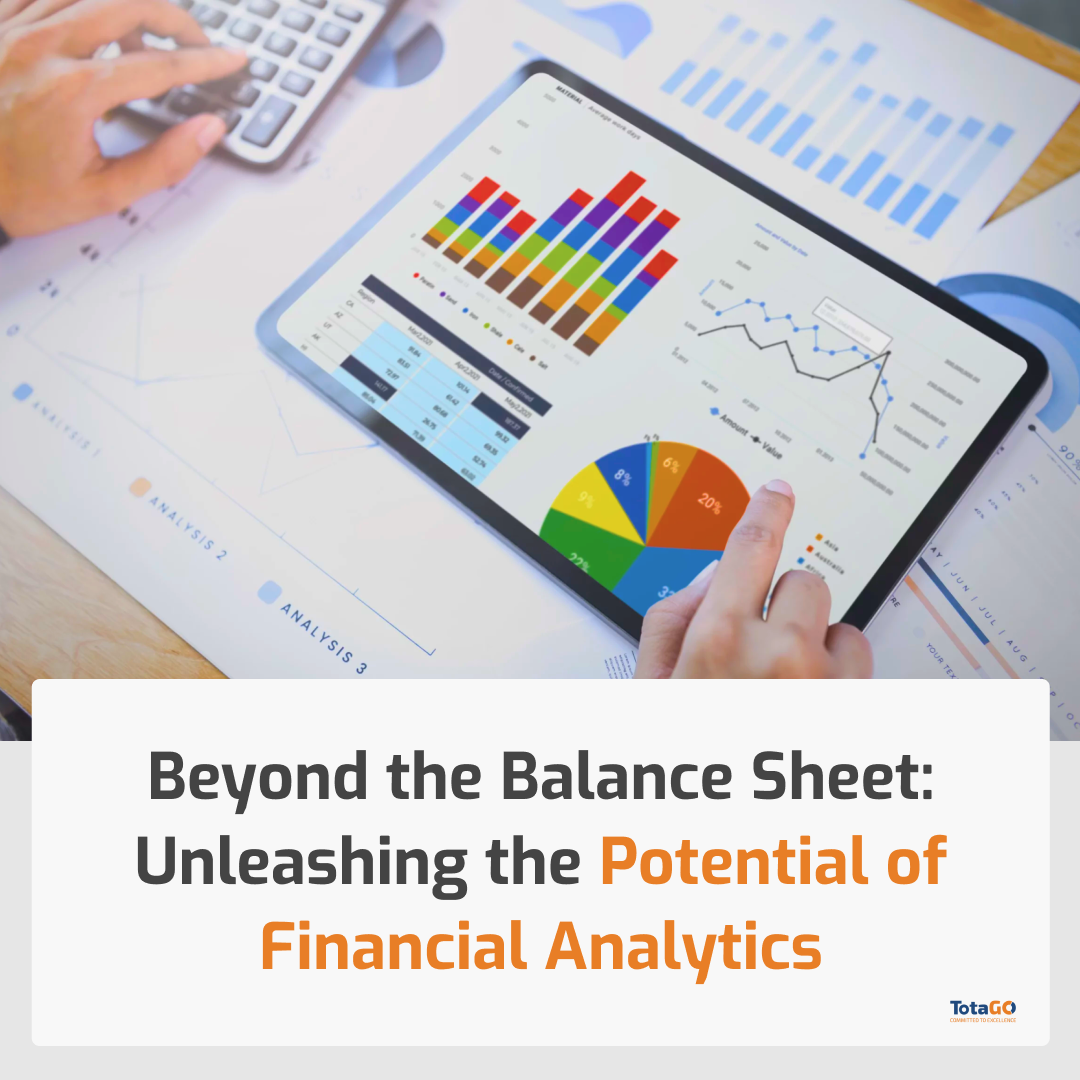What are Financial Analytics and its Sources?
For us at TotaGo, the mere reporting of financial numbers is no longer sufficient for informed decision-making. Beyond the balance sheet we always have a realm of insights waiting to be uncovered through the power of financial analytics. By harnessing the wealth of data available, businesses can gain deeper insights into their financial health.
Also, businesses will be able to mitigate risks, ensure compliance, and drive strategic growth. Let’s delve into the world of financial analytics, exploring its sources, modeling techniques, essential metrics, risk analysis, regulatory compliance, real-time insights, and the future landscape.
Financial Analytics Sources:
- Financial Statements: Traditional sources such as balance sheets, income statements, and cash flow statements provide foundational data for analysis.
- Market Data: External market data such as stock prices, interest rates, and commodity prices offer valuable context for understanding financial performance.
- Operational Data: Data from internal operations, including sales figures, production costs, and inventory levels, can provide insights into efficiency and performance.
- Customer Data: Information on customer behavior, preferences, and purchasing patterns can inform revenue forecasts and strategic marketing decisions.
- Macro-Economic Indicators: Economic indicators like GDP growth, inflation rates, and unemployment statistics provide broader contextual insights into market trends and risks.
How to Model Financial Data?
Modeling financial data involves structuring and analyzing data sets to identify patterns, relationships, and trends. Key steps in modeling financial data include:
- Data Collection: Gather relevant financial data from internal and external sources.
- Data Cleaning: Remove inconsistencies, errors, and outliers from the dataset to ensure accuracy.
- Feature Engineering: Transform raw data into meaningful features that capture important financial relationships.
- Model Selection: Choose appropriate statistical or machine learning models based on the nature of the data and the analytical objectives.
- Model Evaluation: Assess model performance using metrics such as accuracy, precision, recall, and F1-score.
- Iterative Refinement: Fine-tune models based on feedback and insights gained from initial analyses.
What Financial Metrics are Essential?
Several key financial metrics serve as essential indicators of an organization’s performance and financial health:
- Profitability Ratios: Including gross profit margin, net profit margin, return on equity (ROE), and return on investment (ROI).
- Liquidity Ratios: Such as current ratio and quick ratio, indicating the ability to meet short-term financial obligations.
- Debt Ratios: Including debt-to-equity ratio and interest coverage ratio, assessing leverage and debt repayment capacity.
- Efficiency Ratios: Such as inventory turnover ratio, accounts receivable turnover ratio, and asset turnover ratio, measuring operational efficiency.
- Growth Metrics: Including revenue growth rate, earnings per share (EPS) growth, and customer acquisition cost (CAC) ratio, indicating expansion and market performance.
How to Analyze Risks?
Risk analysis in financial analytics involves identifying, assessing, and mitigating various types of risks that may impact an organization’s financial stability and performance. Key steps in risk analysis include:
- Risk Identification: Identify potential risks, including market risks, credit risks, operational risks, and regulatory risks.
- Risk Assessment: Evaluate the likelihood and potential impact of each identified risk on the organization’s financial objectives.
- Risk Mitigation: Implement strategies and controls to minimize or mitigate identified risks, such as diversification, hedging, and insurance.
- Monitoring and Review: Continuously monitor and review risk exposure, adjusting mitigation strategies as needed in response to changing market conditions and business dynamics.
How to Ensure Regulatory Compliance?
Ensuring regulatory compliance is critical for businesses operating in highly regulated industries or jurisdictions. Financial analytics can support compliance efforts by:
- Data Governance: Implementing robust data governance practices to ensure the accuracy, integrity, and security of financial data.
- Regulatory Monitoring: Monitoring regulatory developments and updates to ensure compliance with relevant laws, regulations, and reporting requirements.
- Risk-Based Compliance: Adopting a risk-based approach to compliance, prioritizing resources and efforts based on the level of regulatory risk.
- Audit Trails: Maintaining detailed audit trails and documentation to demonstrate compliance efforts and facilitate regulatory audits and examinations.
How to Use Analytics for Real-Time Insights?
Real-time financial analytics enables businesses to access timely insights and respond swiftly to emerging opportunities and threats. Key strategies for leveraging analytics for real-time insights include:
- Data Integration: Integrating diverse data sources and systems to enable real-time data access and analysis.
- Stream Processing: Implementing stream processing technologies to analyze data in motion and detect patterns or anomalies in real-time.
- Predictive Analytics: Using predictive models to forecast future financial trends and outcomes based on real-time data inputs.
- Automated Alerts: Implementing automated alerting systems to notify stakeholders of significant events or deviations from expected financial performance.
What is the Future of Financial Analytics?
The future of financial analytics is characterized by continued innovation and evolution driven by advancements in technology, data analytics, and regulatory requirements. Key trends shaping the future of financial analytics include:
- Advanced Analytics: Adoption of advanced analytics techniques such as machine learning, artificial intelligence, and natural language processing to extract deeper insights from financial data.
- Big Data: Leveraging big data technologies to process and analyze large volumes of structured and unstructured financial data in real-time.
- RegTech: Emergence of regulatory technology (RegTech) solutions to automate compliance processes and enhance regulatory reporting efficiency.
- Ethical AI: Increasing focus on ethical considerations and responsible use of AI in financial analytics to mitigate biases and ensure transparency and fairness.
- Predictive Insights: Use of predictive analytics to anticipate market trends, customer behavior, and financial risks, enabling proactive decision-making and strategic planning.
In conclusion, financial analytics represents a powerful tool for unlocking insights beyond the balance sheet. This enables businesses to make data-driven decisions, mitigate risks, ensure compliance, and drive sustainable growth. Also, by embracing emerging technologies and best practices in financial analytics, businesses can stay ahead of the curve. Additionally they can thrive in an increasingly complex and competitive business environment. Additionally, this article aims to provide a comprehensive overview of financial analytics, covering its definition, sources, modeling techniques, essential metrics, risk analysis, compliance considerations, real-time insights, and future trends.


